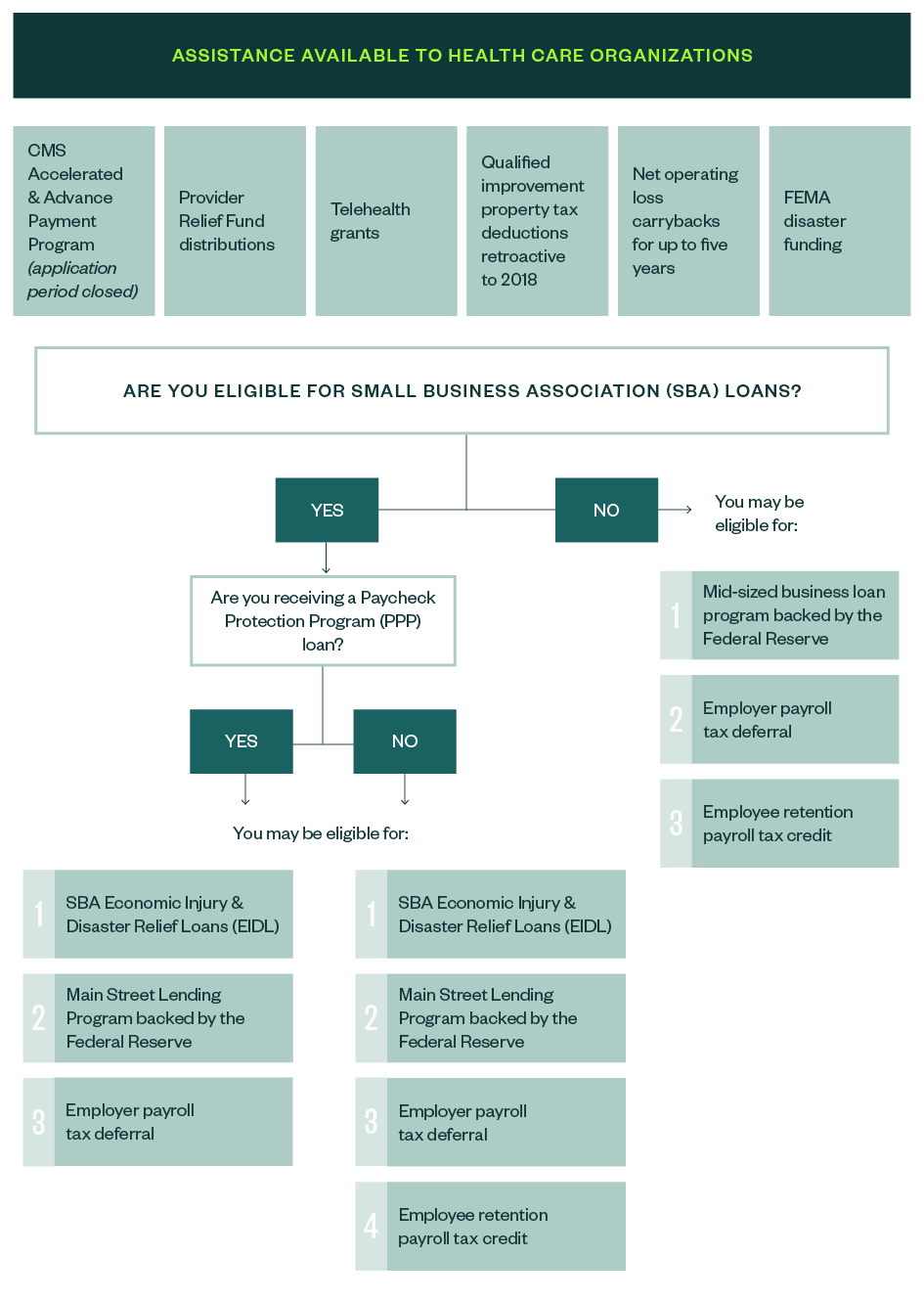
The COVID-19 pandemic has created unprecedented hardships for organizations of all kinds, and the resurgence of positive tests in October 2020 introduces additional uncertainty.
Health care leaders are still having to think quickly and act based on incomplete information. It’s unclear how regulatory agencies banning elective procedures and delaying non-emergent—yet important—clinical testing will affect the health care industry; and while the federal government injected cash into the health system, there are strings attached to much of it.
Every crisis, however, presents opportunities to learn and improve. While the full impact of federal and state decisions might not be realized for quite some time, health care organizations can use the knowledge gained during the pandemic to help improve our nation’s health care system.
Below, we outline five steps health care leadership can apply to help kick-start business strategies, achieve operational goals, and successfully emerge from the pandemic.
Background
Quick decisions made in response to the COVID-19 pandemic, primarily to save medical supplies and increase capacity, resulted in the temporary elimination of all elective services—the economic engine of most health care systems. This had a major impact on hospitals, providers, and patients, and federal funding was provided that helped most health care organizations bolster their cash position.
For health plans or other risk-bearing organizations (RBO), the downstream impact of continued widespread unemployment and the cost of COVID-19 services are still unclear, but the impacts don’t seem to be as devastating as some predicted.
There are many other health care industry constituents with different situations from hospitals and health plans—too many to cite here. Leaders must prepare for continued uncertainty, but should have strategies to do more than just survive. While there are many aspects out of leadership’s control, leaders can influence decision-making processes within their organizations that could help mitigate these issues.
At the executive and board levels, there’s no time to waste in guiding your organization. As a team, and using the knowledge gained through recent experience, it’s paramount to agree on organization targets in the short-, mid-, and long-term, and focus planning and execution to attain them.
Relentless discipline in checking progress and adjusting actions is needed on a scale most organizational leadership teams and boards aren’t used to maintaining. How you formulate and deploy actions matters a great deal.
Just as the emergency response to the virus triggered the need for clinical and operational command centers, the economic repercussions and evolving opportunities to create a better way for health care requires a business-command center—a process whereby leaders strategize and monitor progress towards many important short and longer-term goals.
Kick-Start Your Business Command Center
1. Focus on Cash
The health care industry has received unprecedented financial support from the US Federal Government. While there are some strings attached when receiving these funds, they still provide much-needed relief.
The below graphic outlines steps you can take and opportunities available depending on your company’s circumstances.

The sources of these funds include the following:
- Tax credits and deferrals.
- Centers for Medicare and Medicaid Services (CMS) funding advances. The application period for these funds is now closed, but the recoupment timeline and policies were favorably updated on September 30, 2020.
- US Department of Human Health and Services (HHS) and other federal or state agency grants.
- Federal Emergency Management Agency (FEMA) support and federal loan programs
Operationally, it’s important that your company has an effective revenue cycle, or that it implements strategies to accelerate cash. Now is not the time to take the proverbial foot off the gas, despite the likelihood of organizational fatigue.
2. Develop Efficiency Strategies
The skills you’re learning during the pandemic should include an intense focus on efficiency. Some organizations are deploying staffing, supply chain, and other strategies to reduce costs.
For example, key levers to consider for managing labor costs and efficiencies include the following:
- Eliminate or decrease contract, agency, and traveler utilization
- Manage overtime and premium pay costs by implementing strict protocols and approval process
- Implement a strategic hiring freeze with rigorous position control process
- Develop flex staffing plans for all hospital departments, including both variable and fixed departments
- Push or delay education, orientation, and training (EOT) time to the future to focus labor resources on critical needs
- A reduction in force (RIF) as a last resort, which would include restructuring management to create a flatter organization that’s equipped for quicker decision-making while lowering costs
When looking to redeploy resources after the pandemic subsides, don’t lose sight of what you were able to accomplish during this difficult time. Staffing strategies are challenging to address because they impact your people, but they’re important to consider. By prioritizing efficiency, you’ll be in a stronger position on the other side of the pandemic.
3. Identify What Is and Isn’t Working
With every aspect of your business impacted by COVID-19, there’s significant opportunity to make widespread improvements by assessing the effectiveness of your current operations. Areas for improvement might include the following:
- Enhancements to your crisis response
- Delivery system enhancements, such as Telemedicine
- Business relationship management, including vendors and payer-provider collaboration
4. Focus on Market Position
The pandemic and the ensuing economic crisis are impacting everyone—and they’re forcing evolution in the industry, so leaders must think ahead.
Part of that thought process should be about the market position they want to be in when the dust settles. The harsh reality is that this won’t be the last pandemic, and organizations that will get ahead are those that use this as an opportunity to learn and enhance their market position to emerge stronger than they were before.
Your organization can ask questions to evaluate its current position—and the ideal position. These questions can include:
- Do we have better line of site into the new health care paradigm?
- What do we want to look like in that paradigm?
- Based on our current direction, will we emerge in a position of strength?
- What’s our image in the marketplace and do we want to make changes?
- How are we positioned relative to our competitors?
While the future may not be clear, smart leaders will position their organizations to make the best of what’s to come.
5. Create Dynamic Planning and Deployment Strategies
With many regions seeing significant increases in COVID-19 cases, it’s critical to perform a situational assessment and look for ways to evolve your organization. This is the time to harness lessons learned and focus on recovery and reinvention for your long-term future.
To succeed moving forward, the old paradigm of annual planning needs to be replaced with a much stronger strategy that is exercised day-in and day-out with the leadership team and board.
Additionally, clarity of purpose, strategic targets, and priority projects and initiatives must be clearly deployed throughout the organization. Organizations that are embracing this level of focus, clarity, and discipline will emerge stronger.
To evaluate your organization’s strategic planning deployment processes, consider the following questions:
- What strategic targets are most important to our organization at this time?
- Are we clear on our priority projects and initiatives, and have we focused our resources accordingly?
- How are we operating more efficiently, and can we accelerate our pace of change?
- Are we learning through the pandemic?
- Are we on track to emerge with the ability to invest in our business strategy?
- What have we learned about quality and crisis preparedness, and are we able to prioritize patients and workforce safety?
We’re Here to Help
The COVID-19 pandemic has created unprecedented challenges for companies across industries. And while we aren’t yet out of the woods, it’s never too soon to start planning for future changes. By evolving your organization, you’ll be able enhance organizational resilience and sustainability and keep pace with the evolving health care environment—now and in the future.
To learn more about how to get started, contact your Moss Adams professional.